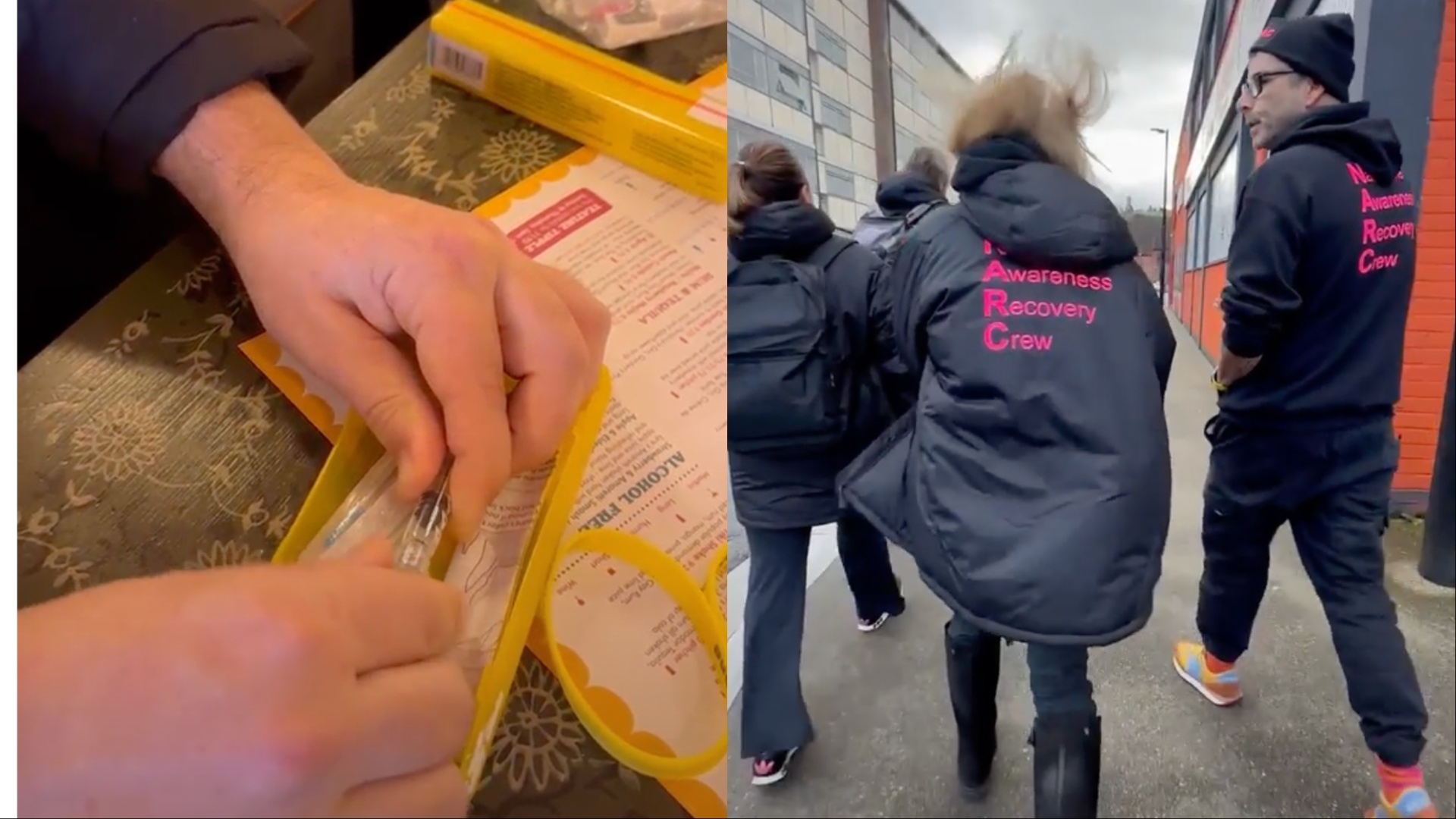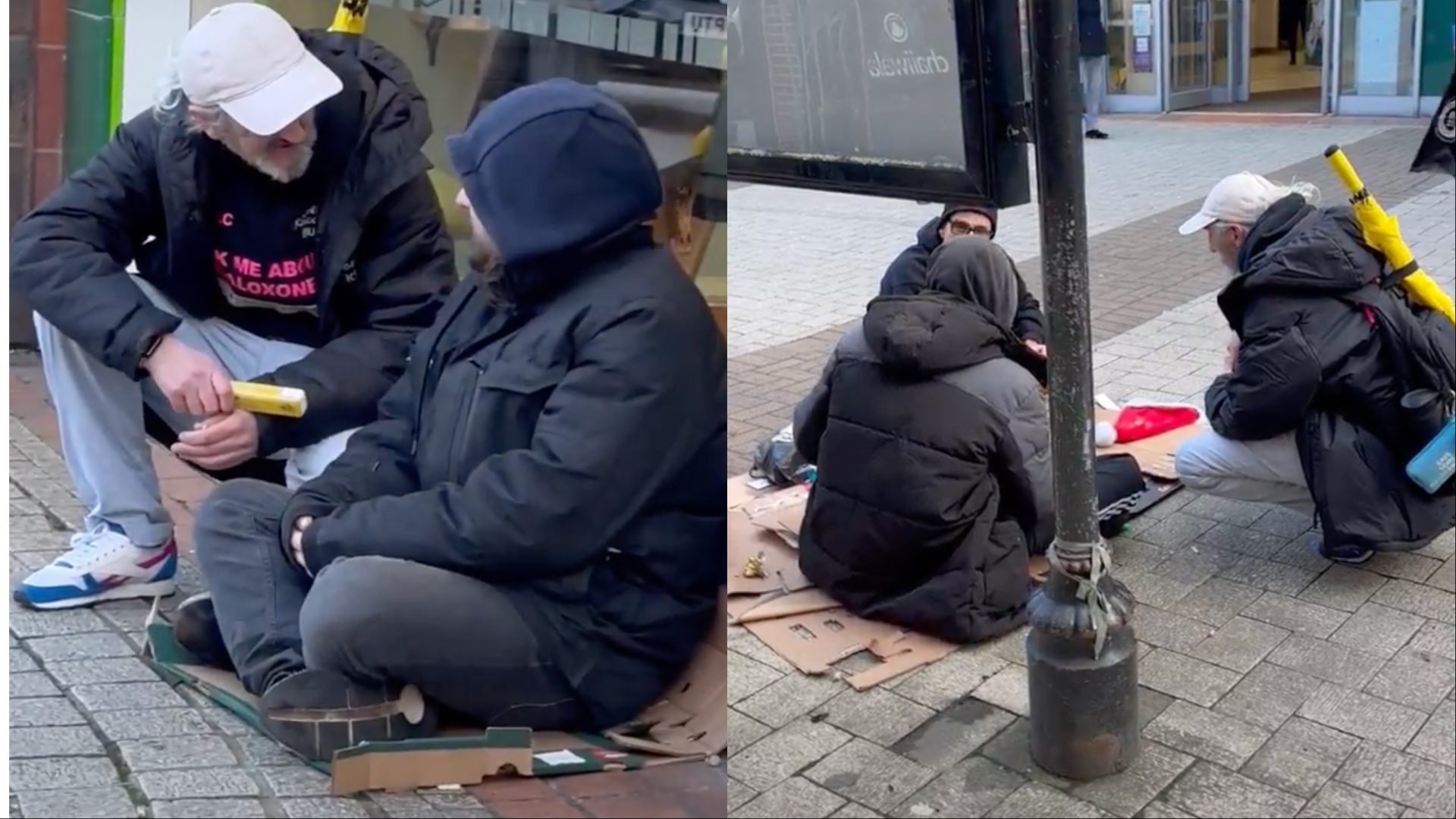Naloxone Man: The IRL Superhero Teaching People How to Reverse Overdoses
February 21, 2024Please note this article features graphic mentions of self harm.
A community centre in a suburban market town isn’t the first place you think of when it comes to the frontlines of Britain’s opioid crisis, but that’s where I am on a cold December morning. One Recovery Bucks has all the usual decor of a drug and alcohol addiction support service – education pamphlets on various substances, a weekly timetable of social drop-in events, and a large kitchen where tea, coffee and biscuits are in endless supply – but one ornament is slightly more unusual. It’s a cardboard mock-up of the life-saving medication Naloxone, and it’s the reason I’ve travelled to Aylesbury, England.
Naloxone – known by its brand name Narcan in the US, where it typically comes in a nasal spray – is a competitive opioid antagonist used to temporarily reverse overdose from opiates like heroin. It’s been used in clinical settings and by paramedics for years, but is increasingly given directly to police officers and the general public to quickly treat those at risk of death.

In 2021, 80,411 people in the US died of an opioid overdose. Over ten years ago, the figure stood at just over 21,000. This staggering increase is largely the result of heroin being replaced with the much stronger synthetic opiate fentanyl at street level, making the distribution of Naloxone an urgent necessity. Opioid overdoses aren’t just an American problem: Office for National Statistics figures show that England and Wales drug poisoning deaths are at their highest level in 30 years, with nearly half of the 4,907 deaths in 2022 involving opiates.
Here in the UK, one man is using a yellow morph suit and a dream to get Naloxone into as many hands as possible. Naloxone Man is the secret superhero identity of 50-year-old George Charlton, a so-called “expert by experience” when it comes to drugs. The big yellow box belongs to him.
“I was a drug user for many years. I had some fantastic times, dancing and travelling during the early 90s rave scene,” he tells me. “But I found that my use of illicit substances led me down a pathway. I found myself just using substances to medicate pain and trauma. I spent a number of years in the prison system, and detained under the Mental Health Act.”
In the year 2000, it all came to a head. “After slashing my own wrists and ending up in a psychiatric unit, I went to a residential rehabilitation centre. I was there for a year,” Charlton recalls. “I wasn't drinking, I wasn't using, but I came out and I was still a mess. Then I recognised that alcohol and drugs weren't the only problem that I had.”
He had no qualifications and had never maintained a job, so he did a basic counselling course at Sunderland College. “The way that certificate made me feel… that was like having a line. I did level two, level three, a postgraduate diploma degree, and then went on and got a Master's in social sciences and health from Durham University.”
The line between passion and obsession is thin, and Charlton does not tread it lightly. For the past 20 years, Charlton has dedicated his career to drug education, rehabilitation and harm reduction. Then three years ago he heard about Naloxone, and tried to get hold of some. He contacted the local drug treatment provider where he lived, but was ultimately told they couldn’t agree to his request, even though he was a drug support worker.
“But I’m very tenacious, me,” Charlton says. “It put a fire in my belly. I thought, ‘I'm not having this.’” He looked at peer-to-peer harm reduction programs set up in the US, and decided to set up something similar up in the UK, which would be able to procure Naloxone. He worked with Danny Ahmed from Foundations Middlesbrough, a pioneering specialist addiction GP service which recently closed its doors.
Now, Charlton travels across the UK delivering peer-to-peer education and teaching members of the public how to use the life-saving drug in under ten minutes. Once someone has been trained in how to spot signs of opioid overdose and administer Naloxone, the volunteer gives them their own handbag-sized yellow box containing a syringe full of the injectable form of the medication, Prenoxad. In the UK, this is considered preferable to the nasal spray for civilian use – not just because it’s cheaper, but because Naloxone can trigger withdrawal, and the injectable allows the patient to come round more gently. This reduces the potential of a frustrated or even violent response from the patient once they wake up.

“The guidance says that anybody who's likely to witness an overdose can carry Naloxone and use it for the purposes of saving a life,” says Charlton. “That used to mean we thought that we needed to get Naloxone into the hands of people who use drugs – and of course we do, but anybody who's walking the streets anywhere up and down the whole of the UK right now is likely to witness an overdose, because people use drugs in our communities.”
This means that if you’re carrying a yellow injectable kit and you see someone displaying signs of an overdose such as unresponsiveness, shallow breathing and blue lips, you can take action, whether you’re a taxi driver with an unresponsive passenger or walking past a homeless person at a bus station. The injectable holds five doses which last half an hour each, so you can wait with the patient for an ambulance to arrive.
One way Charlton spreads awareness is by making TikToks and social media posts as Naloxone Man – a superhero who dresses in fluorescent yellow lycra, a belt made of Naloxone boxes, a bowler hat and printed underpants. His catchphrase, “nice people take drugs”, is designed to remove some of the stigma associated with drug use and people with addiction issues.
Even out of the morph suit, Charlton has the high energy and confidence of a kids TV presenter – an attribute that perfectly suits walking up to complete strangers to ask if they have five minutes to discuss heroin overdose.
Today he’s with the peer group he’s training in Buckinghamshire, and has invited me to join them. They’ve named themselves, playfully, the N.A.R.Cs (Naloxone Awareness Recovery Crew). The N.A.R.Cs meet at One Recovery Bucks for a steering group before heading out, which begins with a check-in. “I’ve become more confident in doing it with more practice,” says Kate, one of the volunteers. “That’s the thing I’m most proud of.”
Nick, a recovering alcoholic and N.A.R.Cs volunteer, agrees. “Sometimes we have good days, sometimes we have bad days, but that’s the way it is. Overall I think it’s going really well.”
It is: One Recovery Bucks rep Ronnie tells the group they have now distributed 200 kits in the area. “200 people are now walking the streets knowing what to do if they ever come across someone who's overdosed, because of what you have done,” he praises.
Charlton chimes in: “Somebody's wife, somebody's daughter, somebody's husband – somebody’s somebody breathes today because yous lot give a shit enough to go out in the pissing down rain.”
Also on the agenda today is a discussion about nitazenes – synthetic opioids that can be up to 43 times stronger than fentanyl – that are beginning to appear in the UK’s heroin supply. The UK has so far largely been unaffected by fentanyl due to the abundance of heroin supplied from Afghanistan, but as the Taliban begins to clamp down on opium farming, Europe could be on the brink of its own synthetic opioid crisis. That means more potential overdoses and deaths – a risk that could be mitigated if Naloxone is made widely available across the UK.
“I read this morning that nitazenes have been responsible for 54 deaths in the past six months,” Charlton tells the group. “People who use drugs, we tend to go looking for the stuff that's stronger. For us it's about not using those words. We're not talking about ‘strong’ nitazenes, we're talking about contamination.”
After the meeting, the group disperses around the building as they prepare to walk into town. Sean, one of the volunteers, is training a police officer in how to administer nasal Narcan.
I chat to Kate, who tells me that part of the focus at the moment is in getting Naloxone into as many medical kits as possible, particularly in town-centre spaces like libraries and hairdressers, “a bit like an EpiPen”.
When we reach town, the volunteers step into action, walking around different areas of Aylesbury wearing matching hoodies that say “ASK ME ABOUT NALOXONE” in bright pink.
They approach whoever looks like they might be willing to listen, going into shops, knocking on the doors of churches, and speaking to homeless people, almost like Naloxone evangelists.
At a bar, Nick and Sean go through their tutorial with one of the staff members. One of the steps involves demonstrating how to inject Naloxone by plunging a needle into a juggling ball. As we step outside, Nick turns and says: “Even six months ago I probably wouldn’t have done what we’ve just done, going into a pub. But now I find it easier – my cravings for drink have gone. It’s all part of giving back. That’s all I want to do with my life at the moment.”
Sean, who was homeless for two and a half years due to a crack and heroin addiction, agrees. “We’re trying to change the idea that addicts are the worst that society has to offer, because we’re not. They’re just people in a bad place at the minute.”
I ask if he feels proud of himself, doing the volunteering. Sean laughs uncomfortably: “I really struggle with compliments, that’s one of my things. I’m terrible at believing in myself. But everyone else has told me I’m completely different now, compared to what I used to be.”
“You are,” chimes in ‘Mighty’ Mick Bird, a former peer volunteer from the Newport group who now assists Charlton in establishing programs around the country. “The guy I met three months ago is a totally different guy to who is standing in front of me. You were sitting down, didn’t want to talk to no one, eye contact on the floor. Now you’re talking to people’s eyes, not their shoes.”
Sean’s change is reminiscent of Mick’s own journey. Later that day, he tells me he used to keep a baseball cap over his eyes. Now he leads training sessions. “This programme, it symbolises that you care about people who are homeless. You care about people using drugs. You show compassion to people who are not really shown a lot of compassion from people.”
Sadly, Mick’s had to administer Naloxone more than once. “I’ve administered Naloxone two or three times, so I’ve saved people’s lives,” he says. “When I was using, I overdosed and got dragged out and left in a bin chute to die, so I know how it feels.”
“It's easy for us to go and do [the street training] because we've been there,” Charlton says of helping those on the streets. “We've been broken, we've felt what it feels like when nobody cares. They're our people.”
